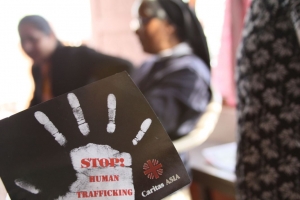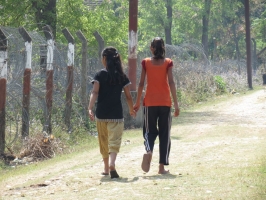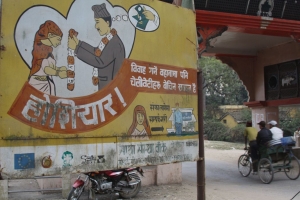Through a combination of awareness-raising programmes, radio outreach and training, Caritas Nepal is working to prevent human trafficking, unsafe migration and violence against women along some of Nepal’s border areas. It has reunited child migrants with their families, and provides services to survivors of unsafe migration and domestic violence. It also supports efforts to ensure that Bhutanese children living in refugee camps receive a good quality education. Contact: [email protected]
Protecting Nepalese children from trafficking and unsafe migration

Sister Pamela Gulung, right, helps raise awareness of human trafficking in eastern Nepal. Credit: Laura Sheahen/Caritas
Problems such as child labour, child sexual abuse, child marriage and street children are widespread in Nepal – and they are all linked to child migration. Poverty in this landlocked country, where most people earn a living from agriculture, is the main driver.
Despite efforts by the government and local and international non-governmental organisations (NGOs) to spur growth and development, the country’s difficult terrain – many villages are remote and inaccessible – and lack of adequate infrastructure, such as roads, hospitals and schools, keep people trapped in a cycle of poverty.
The reasons why Nepalese children leave home vary. Some are sent away by their parents to find work – within the country or beyond – to help provide for the family. Others leave to escape a troubled home life. Many end up begging on city streets, where they are often lured into drug dealing or other illegal activities, while others become labourers – on construction sites, in factories, as domestic help or as circus entertainers. Young girls, in particular, risk falling into a life of prostitution.
Nepal’s child migrants work long hours, often logging in more than 12 hours a day, in jobs that are poorly paid and often dangerous. Far from home and living under their employers’ orders, they are vulnerable to abuse, be it sexual, mental, verbal or physical. Their living conditions are generally poor and unhygienic, and food, healthcare and rest can be scarce. But they have little choice, as they need to earn money.
Legislation
- The Government of Nepal has a number of policies and legislation in place to combat child labour.
- The 1990 Constitution of Nepal seeks to protect children, ensure their safety, stop them from being exploited and arrange for their free education.
- The 1992 Children’s Act aims to protect the physical, mental and intellectual wellbeing of children, ensuring they receive all the rights they are entitled to. It also contains provisions regarding child labour and has recently been amended to specifically target abuse, especially sexual abuse. The Act defines a child as any person below the age of 16, and prohibits children under the age of 14 from engaging in any type of employment or labour.
- The 1992 Labour Act and the 1993 Labour Rules prohibit children under the age of 14 from engaging in any type of employment, and minors (14 to 18 years of age) from undertaking any type of hazardous work.
- The 1999 Child Labour (Prohibition and Regulation) Act, which made amendments to the 1992 Labour Act, follows Nepal’s ratification of the International Labour Organization’s (ILO) Minimum Age Convention (No. 138). The Act defines certain types of work as hazardous, and bans children under the age of 16 from engaging in such work. It also specifies working hours for children between 14 and 16 years of age, prohibits work from 6:00 in the evening to 6:00 in the morning and prohibits any kind of employment of children under 14.
- The 2001 Kamiya Labour Prohibition Act prohibits bonded labour and has helped free many children working as labourers.
- There are a number of other legal provisions aimed at restricting child labour and trafficking in Nepal, and the government is also working to ensure that all children have access to education by 2015.
Reality

In Sanoshree-area villages in the Bardiya district of western Nepal, impoverished girls and women are vulnerable to employment scams and human trafficking. Credit: Laura Sheahen/Caritas
Despite Nepal’s legal landscape to protect children, the migration of minors continues to take place on a large scale. Children are moving to cities such as Kathmandu or Pokhara, or neighbouring countries, in search of work. The ILO estimates that 2.6 million children between 5 and 14 years of age are engaged in some form of labour, working on farms, in factories or mines or as domestic help, among others. The Child Workers in Nepal Concerned Centre identified 15 different areas of work. Of the 2.6 million children working, 127,000 are involved in some of the worst types of labour, such as commercial sex work or bonded labour.
A large number of migrants go to India. The ILO estimates that 12,000 women and children are trafficked to India annually, and the Centre for the Study of Labour and Mobility says that children between 15 and 17 years of age are the most active in terms of migration, with India as their main destination. The Centre also reports that among educated children, the number of males migrating is higher than females, but that marriage-related migration may account for the overall higher mobility of female children between 10 and 17 years of age. Many children who migrate also experience “occupational shifts” as they have to switch from agricultural to non-agricultural labour.
Caritas Nepal’s work
With support from Caritas Italiana, Caritas Nepal has been carrying out a prevention programme on human trafficking, unsafe migration and violence against women in Jhapa and Morang – two districts that border India. It is the continuation of a three-year anti-trafficking programme. According to the Government of Nepal, Jhapa is one of the most heavily trafficked areas. Migration, through authorised and unauthorised agencies, to India and other countries is on the rise. Those falling into the trap of unsafe migration often end up being trafficked.
Caritas Nepal is working to raise awareness of the dangers of unsafe migration and trafficking, especially among women and children in villages. It is training trainers and providing refresher courses to government schoolteachers and refugee camp schoolteachers, who in turn are organising awareness-raising programmes in their respective schools and communities.
It is using radio programmes such as Sachetana (which means awareness) to share stories from the victims’ friends and families. In particular, people from Jharsadhi village in Morang district gave interviews and testimony to Radio Nepal staff, which were aired on the programme.
Caritas Nepal’s executive director and staff, as well as lawyers, experts and social activists, have broadcasted messages on these issues, and an information booklet on safe migration has been published and distributed throughout the project areas.
Caritas Nepal’s Information Communication Centres provide services to the survivors of unsafe migration and domestic violence, and have helped keep young girls and women safe from human trafficking. The village-based centres disseminate news, provide basic counselling to survivors and advise them on possible steps for obtaining justice, mainly by putting them in contact with lawyers or other agencies that could provide further assistance. Caritas Nepal’s work through the centres’ network has garnered the attention of local government agencies, NGOs and community-based organisations.

Caritas Nepal runs awareness-raising sessions so that people will be wary of fast-cash offers from traffickers. credit Laura Sheahen/Caritas
Caritas Nepal has also carried out rescue operations, helping to bring children home safely. In one case, upon learning that a child was in police custody in southern India after being caught working in a factory there, the Information Communication Centre contacted Caritas Nepal for help in tracing the child’s parents.
Visits were made to the child’s village, and siblings, other relatives and neighbours were interviewed. They learned that the parents, unable to cope with family expenses, had sent the boy to work in India. The father, the family’s main breadwinner, died later, leaving the family saddled with debt. The child was eventually reunited with his family in Nepal and is now enrolled in school, thanks to the efforts of an organisation called Child Care Nepal.
In another case, after two teenage girls ran away from home, one of the girl’s mothers contacted Caritas Nepal for help in locating them. Caritas staff members were able to track down the young girls’ whereabouts, aided by text messages sent by the trafficker. They managed to rescue the girls, literally running in to the woods to retrieve them. With support from Caritas Nepal, the girl’s mother now runs a teashop, earning enough money to send her daughter to school.
Main recommendations
- Greater efforts need to be made by the Government of Nepal and implementing agencies to create a safe environment for children in the long term.The Government of Nepal needs to properly implement the laws, rules and regulations to protect children, as well as the conventions that have been ratified, so they exist not just on paper, but also in practice.
- The international community should monitor the situation and compel the Government of Nepal to honour its duties and responsibilities towards children.
Implementing agencies should adopt a bottom-up approach so that programmes and projects directly benefit the children who are really in need. - Efforts should be made to raise the awareness of parents and children about child labour and migration, helping them to understand the problems and dangers faced by children who migrate via unsafe channels. These awareness-raising programmes should be carried out throughout the country, especially in remote villages and border areas where families and children are most susceptible to unsafe migration and trafficking.
- Security should be stepped up along Nepal’s borders with India and China to combat the trafficking of women and children.
- Since poverty is at the root of the problem, the Government, as well as national and international NGOs, should give priority to poverty eradication programmes, including training on income-generating activities so that people can earn money beyond subsistence farming.
- Education should be provided to all children, boys and girls alike, so they can acquire knowledge and become empowered.
